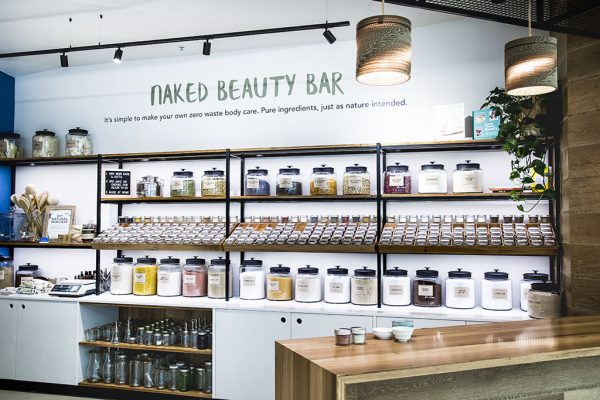I bought my dream home almost a year ago. Classic 80s-style brick, complete with gorgeous high, raked ceilings, exposed beams, and zero insulation. One of the many homes built before energy efficiency standards were introduced in 2003.
Which meant despite our Gold Coast winters being reasonably mild and having a north-facing frontage with plenty of sun exposure, the house was freezing inside. Like most Australian homes, when our predecessors built them, they couldn’t decide whether to build for the heat or cold, so they did neither.
One of the biggest considerations when planning our house renovation was energy efficiency.
In the midst of researching solar, types of windows, and energy-efficient appliances, we quickly realised that insulation was the most affordable and effective way to make the house not only more comfortable but also keep the energy bills down.
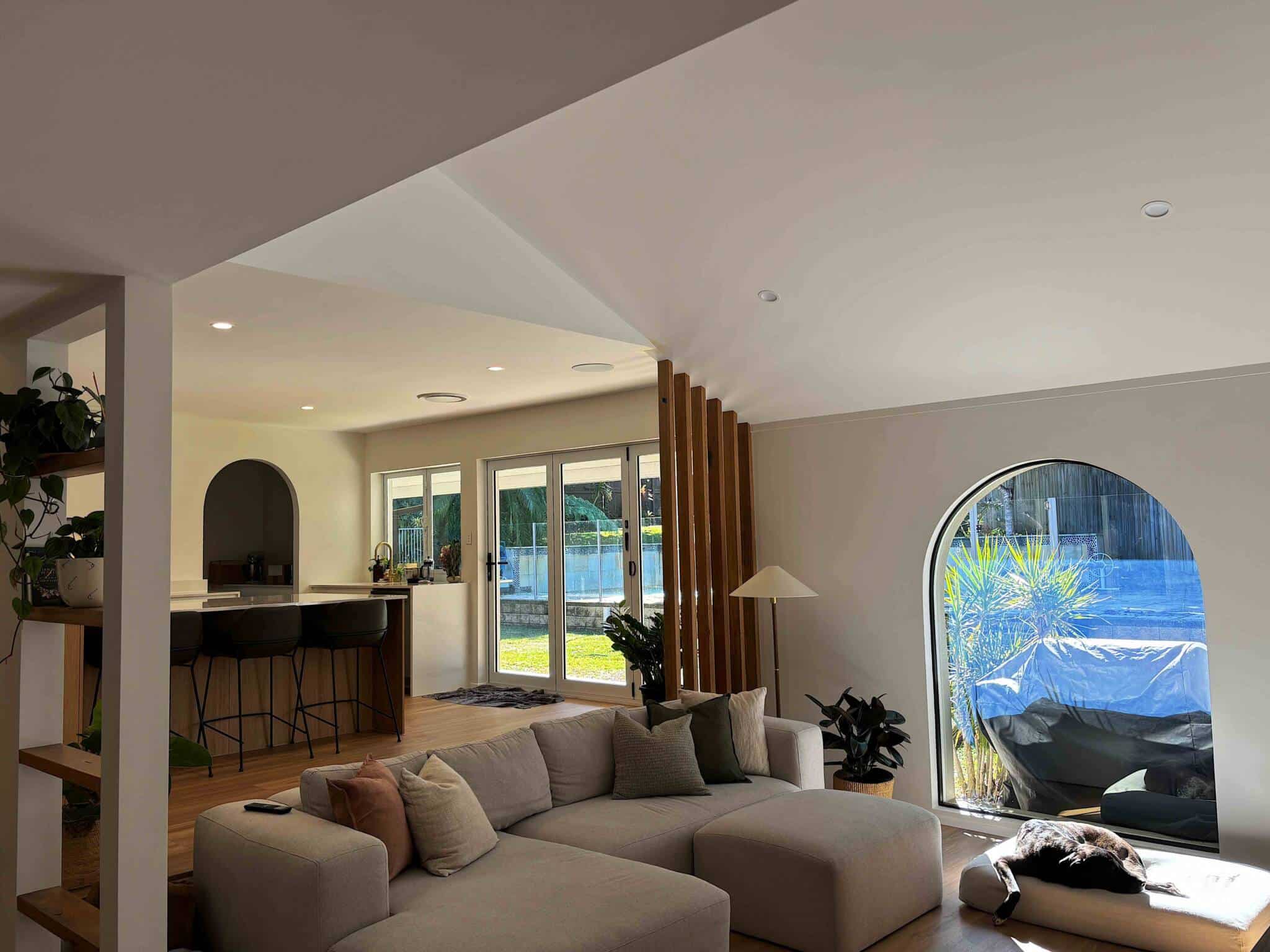
Why Insulate?
So why should we bother with insulation? Simply, insulation is essential for maintaining a consistent temperature in your home.
It acts as a thermal barrier to heat flow; it keeps the heat inside in winter and outside in summer, so you won’t need to rely as heavily on heating and cooling systems.
This also means it will help cut your electricity costs and reduce your carbon footprint—two big wins in my book.
Proper insulation also helps with moisture control, reducing the risk of mould and mildew, and can even improve the soundproofing of your home. Essentially, insulation makes your home more comfortable, healthier, and quieter.
It’s now June, a year later, and we’ve lived in the house for almost a month. The main living area (kitchen, lounge, entryway), plus the main bedroom and my office, are on the north side of the house – this part of the house is now fully insulated in the roof and walls, and we’ve noticed a considerable difference in the warmth of these rooms.
The sensors on the ducted aircon remote tell us the northside rooms maintain a cool but liveable 18-20 degrees overnight – this is without heating. The south side of the house, which has no insulation – the bathroom, gym, Dave’s office, and laundry – drops to 15-19 degrees.
A few degrees might not sound like much, but it makes a big difference in comfortability. When we fire up the heat, it only takes 5-10 minutes for the north side of the house to come up to a very comfortable 24 degrees.
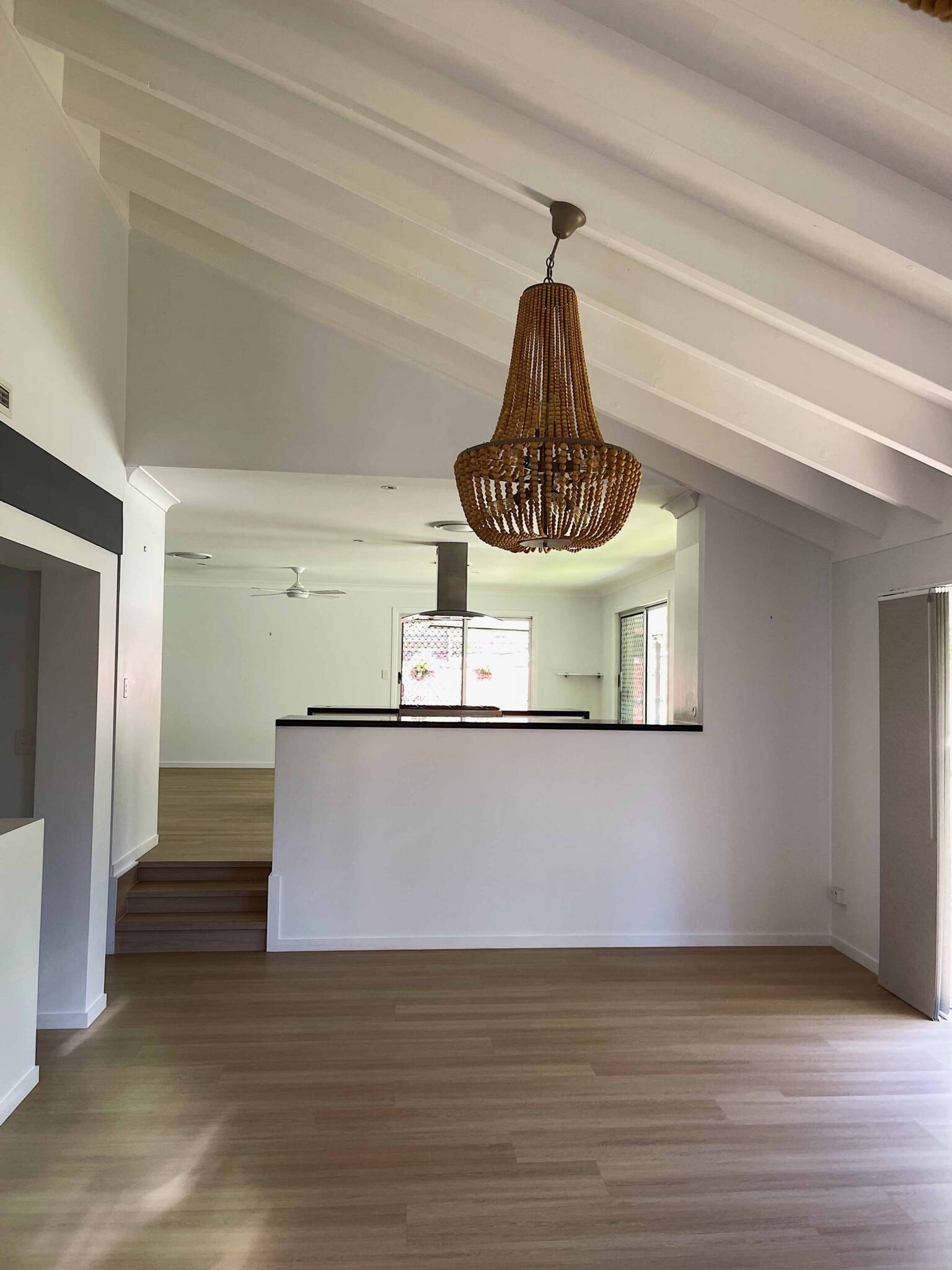
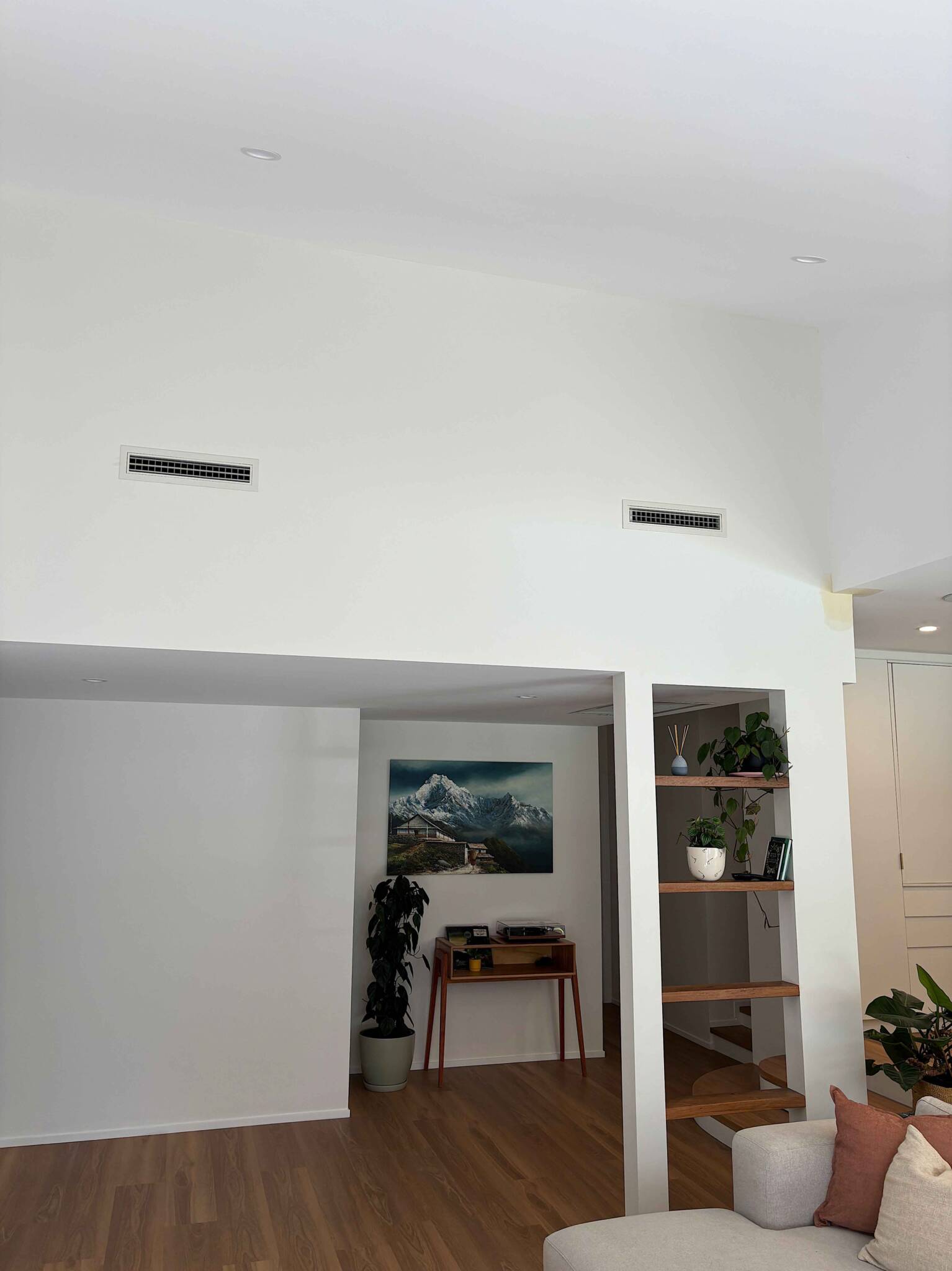
Not all insulation is made equal
So, what makes insulation effective? A few things.
The most commonly used insulation is bulk insulation – your batts and fill – which traps millions of tiny pockets of still air within its structure. The air pockets provide resistance to heat flow, which gives the material an insulating effect.
The performance and thermal and acoustic resistance are measured as an R-value. The higher the R-value, the more effective the material is at resisting unwanted heat flow, meaning less energy is needed and ultimately lower bills.
Australian standards and building regulations specify the minimum R-values for different areas. The right R-value for your home depends on your climate zone. For example, a home in the cooler southern regions will need a higher R-value than one in the tropical north.
Choosing the Right Insulation for Your Home and Values
Now we get to the good stuff. What sort of insulation will suit your home and your values?
There are three main types of insulation.
- Bulk insulation uses air pockets within a thick material to slow the flow of heat.
- Reflective insulation reflects heat back to where it came from, and if double-sided does not re-radiate heat on the opposite side.
- Composite insulation combines bulk insulation with a reflective surface.
I’d recommend checking out this guide by Your Home. It covers those three types of insulation and where/how best to use them in your home.
Onto the materials and the sustainability of the five most common types of insulation in Australia..
1. Natural Wool Insulation
Wool excels at regulating temperature. It keeps your home warm in the winter and cool in the summer, much like it does for sheep.
Pros: Excellent for thermal regulation and moisture control. Wool is naturally fire-resistant, thanks to its high nitrogen and water content. It doesn’t easily ignite and can help slow down the spread of flames. Wool can absorb and release moisture without losing its insulating properties, which helps to control humidity levels in your home and reduces the risk of mould and mildew. The lanolin in the wool makes it naturally resistant to most pests.
Cons: It tends to be the most expensive type of insulation, probably not the way to go if you’re on a budget. While wool naturally deters some pests, it can be susceptible to others, such as moths. To counteract this, it often requires treatment with chemicals like boric acid or permethrin, which might detract from its natural appeal.
Sustainability: Wool insulation is a highly sustainable option because it is a renewable resource that is biodegradable at the end of its life cycle, and its production typically involves minimal processing, reducing its overall environmental impact. However, wool production typically requires a large amount of water and land resources for sheep farming, But that could be offset by its longevity, reusability, and recyclability/compostability.
2. Rockwool (mineralwool) Insulation
The most common type of insulation. Rockwool, or mineral wool, is manufactured from molten rock or industrial waste products spun into fibres.
Pros: Exceptionally fire resistance. Made from molten rock, it can withstand extremely high temperatures. If you value peace and quiet, rockwool is your friend. Its dense structure makes it fantastic at soundproofing, reducing noise from outside or between rooms. Rockwool doesn’t absorb water, so it stays effective even in damp conditions. It’s generally not made with formaldehyde in the manufacturing process. Instead, use binders that are bio-based or phenolic resin, made from synthetic polymers, which is designed to have low volatile organic compound (VOC) emissions, making them safer for indoor air quality.
Cons: Installing rockwool can be a bit of a workout. It’s dense and fibrous, which can make it challenging to cut and fit into place. Plus, it can irritate the skin and respiratory system, so wearing protective gear is a must. If you’re more on the low-tox living side, more research should be done on the types of binders used in the specific insulation you’re considering.
Sustainability: The process of making rockwool is energy-intensive. While it uses recycled materials, the high energy requirement for manufacturing can be a drawback in terms of overall environmental impact. The fibrous nature of the material and the binding agents used make it difficult to recycle. Some manufacturers offer take-back programs or recycling initiatives, but these are not widespread across Australia.
3. Polyester Insulation
Polyester insulation is typically made from recycled plastic fibres, such as PET bottles.
Pros: It is non-allergenic and safe to install with no PPE. It’s also resistant to mould, mildew, and pests. It does not absorb moisture, and it’s tough. It maintains its structure and insulating properties over time, so you’re looking at a long-lasting solution that won’t sag or settle.
Cons: Where polyester falls short is the lower R-value per inch compared to other materials. This means it might not be as thermally efficient in thinner layers, and you might need thicker insulation to achieve the same level of thermal resistance and acoustic properties.
Sustainability: Many polyester insulation products are made from recycled plastic fibres, like PET bottles. So, you’re helping to reduce landfill waste and giving those old bottles a new lease on life. Although it’s made from recycled materials, polyester itself isn’t biodegradable and likely not recyclable. So, when it eventually needs replacing, it will still contribute to landfill waste.
4. Glass Wool Insulation
Glasswool is made from recycled glass and sand, which are melted and spun into fibres.
Pros: Glasswool is generally affordable, making it a budget-friendly option. This material offers solid thermal insulation, keeping your home warm in winter and cool in summer. Plus, it’s great at absorbing sound, which helps to create a quieter indoor environment.
Cons: Like rockwool, one of the main downsides is that glass wool can irritate the skin, eyes, and respiratory system due to tiny glass fibres. Protective gear, like gloves and masks, is a must during installation. Some brands still use formaldehyde as a binder, so you’ll need to check the labels. Glasswool can settle or compress over time, potentially reducing its insulating efficiency. Proper installation can mitigate this, but it’s something to be aware of. While it’s not highly absorbent, glasswool can still be affected by moisture, which can reduce its insulating properties and lead to potential mould growth if not properly protected.
Sustainability: Glasswool includes a high percentage of recycled glass, reducing the need for new raw materials and decreasing waste. While the material is technically recyclable, the process is complex due to the need to separate the glass fibres from the binders and other materials. Recycling glass wool insulation in Australia is limited. Few facilities can handle this process, so it often ends up in landfill unless specific recycling programs are in place.
5. Cellulose Fibre Insulation
Cellulose fibre is made primarily from recycled newspapers, cardboard, and other paper products.
Pros: Cellulose insulation has a high R-value, which means it provides excellent resistance to heat flow. This helps to keep your home warm in the winter and cool in the summer. The dense nature of cellulose fibres makes them excellent at absorbing sound, reducing noise transmission between rooms and from outside. Cellulose can be blown into spaces, ensuring a tight fit that minimises gaps and voids. So no air leaks.
Cons: Cellulose needs to be kept dry to maintain its effectiveness. If it gets wet, it can clump and lose its insulating properties, potentially leading to mould growth. Over time, cellulose can settle, which may reduce its R-value. Proper installation can help reduce this. Installing cellulose insulation typically requires specialised equipment and professional expertise to make sure it’s done correctly and won’t settle, causing air gaps.
Sustainability: Since it’s made from up to 85% recycled paper products, cellulose insulation is one of the most environmentally friendly insulation options available. It’s biodegradable and uses minimal energy in manufacturing, making it one of the lowest-impact insulation materials.
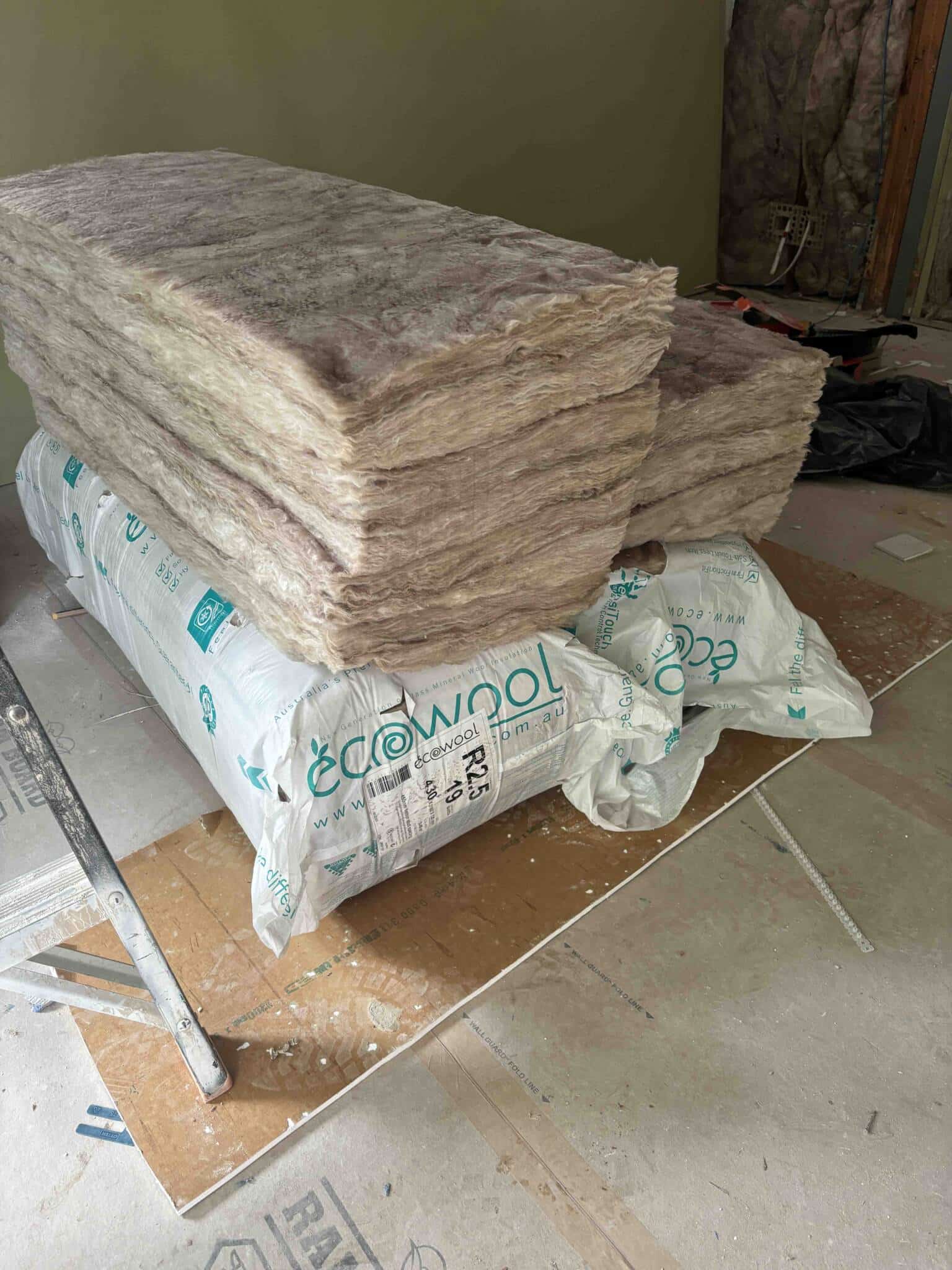
Which type of insulation?
So, what did we end up going with in the end for our renovation?
Initially, I wanted to use recycled polyester batts. Recycled material, safe to install. But we were both concerned about the acoustic performance. With two people working from home and my office sharing a wall with the main living area, we thought it may not provide enough of a sound barrier.
I was very much sold on the cellulose fibre; it ticked all the boxes, except that fact it’s incredibly messy to install and not easy to install when you’re renovating with partial construction.
But, in the end, we decided to go with ecowool, a type of glasswool that uses natural anti-formaldehyde binder, resulting in low volatile organic compounds (VOCs) so no off-gassing over time (the same as the no VOC paints we chose).
The batts are softer to touch, designed to be comfortable, less dusty and less itchy, significantly reducing the irritation experienced during installation, though PPE is still advised. It’s also fire and moisture-resistant and durable. It retains its form and shape well for a soft touch batt; it won’t sag or bunch over time.
For the ceilings, we used R3.5 batts, this was the optimal R-value for our mild Queensland winters and scorching summers. For the internal walls we went with R2.5 for a good balance of thermal and acoustic performance. So far, it’s working well.
